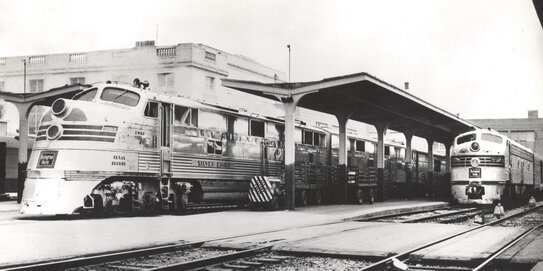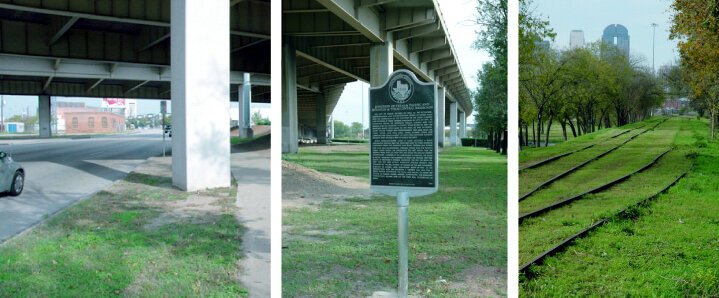A History of Railroads in Dallas
Dallas Union Depot, (ca.1885-1935) at the junction of Houston & Texas Central and Texas & Pacific Railroads (Now Central Expressway & Pacific Avenue) Photo ca. 1910, Dallas Public Library, History & Texana Archives.
"... my trip was not in vain, Dallas is a bright young town, full of promise." 1873
These words were recorded in a letter by an early traveler upon his arrival in Dallas. His journey was by train. The year was 1873 and the railroad had just reached Dallas from Houston a year earlier. Dallas had been chartered a mere 17 years previous. This burgeoning town would soon become the intersection of the first east-west line due to skillful maneuvering by local politicians. The arrival of these two major rail lines set the stage for a period of growth ultimately making Dallas the center for commerce in the Southwest - unprecedented for a city without a major river or seaport!
With the arrival of the Houston & Texas Central Railroad (H&TC) in 1872, John Neely Bryan, considered the founder of Dallas, would realize his vision of the city becoming a rail destination. Several astute businessmen had followed the progression of the H&TC line as it built northward from Houston. They sold general goods to construction crews along the line, and would settle in Dallas on speculation that the Texas & Pacific Railway (T&P) would arrive from the east within a year. These entrepreneurs established businesses which are household names in Dallas today. In 1873, the H&TC continued to build northward to Sherman, connecting with the Missouri-Kansas-Texas Railroad. This connection would link Dallas with industries in the Northeast and Midwest, providing a direct route for much needed materials and machinery for the bustling young town.
Texas & Pacific passenger train, Dallas 1870s, Dallas Public Library
Several North Texas towns had been keeping up with Dallas’ growth, but that would change by the end of 1873. As the T&P Railway built westward toward Fort Worth and El Paso, it crossed the H&TC line at a point known as Browder Springs. Local politicians had introduced last-minute legislation in Austin that required the junction of the two railroads to be located at this little-known spot. Unbeknownst to the competition at the time, Browder Springs was actually Dallas. This junction of two major rail lines would draw people and businesses from all over the U.S. as well as neighboring towns. Towns such as McKinney to the north and Ennis to the south were suddenly at a disadvantage.
Early Dallas railroading is depicted in this exceptional image of the Missouri-Kansas-Texas Railroad roundhouse. In this turn-of-the-century view, “Katy” steam locomotives await their assignments on tracks just beyond the turntable. Notations on the back of the photograph by roundhouse worker Frank Turner reveal priceless information about working for the railroad and living in early Dallas during the Trinity River flood. “Day Crew of Katy ‘Fire Knockers,’ January 21, 1908. MKT RR Roundhouse at Dallas. I am on left in picture. We got $1.60 for 10-hour day. On May 22 to 25th, 1908 the big flood came and there [were] 4 engines standing here and only the top of smoke stacks were above water."
Photo courtesy of Katy Railroad Historical Society
The increase in rail service and the attendant growth of Dallas’ central business district was not without problems. By the early 1900s, the city found itself in daily conflict with the very source of its prosperity. Rail lines crisscrossed the downtown area, with passenger and freight stations scattered throughout. These crowded and confusing conditions were suffocating Dallas. The solution came in 1911 when the Kessler Plan was unveiled. This master plan for Dallas included a detailed proposal for building a “belt” rail line around Dallas to be used by the railroads currently serving the central business district. Along this line on the western edge of town would be a new “union” station, a consolidation of seven railroads and five passenger depots. The city quickly adopted nearly every aspect of the plan.
By October 1916, the Dallas Union Terminal Company opened its doors with its magnificent renaissance style station, the largest of its kind in the Southwest. Dallas was finally free to move about without interference from trains, while the railroads were able to serve the city from its perimeter via the new belt line. Union Terminal would see nearly 80 arrivals and departures a day during its peak years of the late 1920s. This marked the Golden Era of rail travel, when passengers to and from Dallas could enjoy a restful night's sleep in plush Pullman cars and dine on sumptuous meals in dining cars aboard long-distance trains serving Union Station.
Burlington "Zephyrs" arrive & depart Dallas Union Terminal ca. 1950
R. S. Plummer, Burt C. Blanton Collection
Trains were the preferred mode of travel in the 1920s. However, by 1930, the affordability of the automobile triggered an irreversible decline in rail passenger service. After a surge in business during World War II, the once busy Union Station would see fewer and fewer trains. By the 1960s, the completion of the Interstate Highway system and the introduction of commercial jet aircraft would signal an end to passenger trains in Dallas. In May of 1969 T&P Conductor J. K. Welch would call “all aboard” for the final departure of the Texas Eagle and Union Station would close its doors on nearly 100 years of rail service. Dallas was left as the largest city in the U.S. without passenger trains.
But the story was far from over. Dallas would soon see a resurgence in rail service. The advent of Amtrak in 1971 brought passenger trains back to Union Station two years later. Today, Amtrak is joined by DART’s Light Rail and TRE Commuter train service. Meanwhile, the private freight railroads were setting records in the transportation of intermodal traffic, chemicals, and bulk commodities. With the opening of RailPort just south of Dallas, the city is now adjacent to a major distribution center for rail freight traffic. This facility serves as an inland international port for rail and sea container traffic and reduces congestion at traditional border and coastal ports. Dallas is also a destination on several proposed high speed intrastate passenger rail corridors.
While Dallas is recognized more as an aviation center today, it owes its early growth and prosperity to the railroad. Without the intersection of two major rail lines being located in Dallas, McKinney was favored to have been the metropolis of North Texas. Ironically, rail has become the ideal mode to alleviate future congestion in the air and on the roads in Dallas and North Texas. The very form of transportation that put the region on the map will ultimately play a significant role in addressing critical transportation issues.
The Museum of the American Railroad at Fair Park now maintains an outstanding collection of early 20th century trains that contributed to the development of Dallas and the Southwest. But, what is old is new again. The museum’s future programming will address current and new technologies unique to the rail industry that will ensure our mobility and a cleaner environment in the future.
Amtrak's southbound Texas Eagle departs Dallas Union Station, 1985
Southern Pacific / Cotton Belt freight yard on south edge of Dallas CBD, ca. 1951
Missouri-Kansas-Texas Dallas Yard, 1987, present location of Victory Park
The last vestige of early railroading in Dallas, Southern Pacific's (H&TC) recently closed Eakin Street Yard Office awaits an uncertain fate in Summer, 1963. This venerable building would move to Fair Park in September of that year, having escaped the wrecking ball during I-30 construction south of downtown. Today it serves as the Museum's visitor center, gallery, and retail store. Its original location at the southern end of SP's downtown Dallas yard is the site of today's Farmer's Market.
November 13, 2009 - Dallas County Judge Jim Foster unveiled a new historical marker by the Dallas County Historical Commission and the Texas Historical Commission commemorating the first railroads in Dallas. The marker is located on Pacific Avenue under Interstate 45 in downtown Dallas, the original intersection of the Houston & Texas Central Railroad (1872) and the Texas & Pacific Railway (1873). This is the approximate location from which the original ca. 1910 photograph (at top) was taken.
Views at left and center are in relation to the new Historical Marker. Left view is looking east along present-day Pacific Avenue (former Texas & Pacific Railway main line alignment). Center image is looking south under present-day Interstate 45 overhead deck (former Houston & Texas Central main line and approximate location of original depot) adjacent to Dallas CBD. View at right is south of downtown Dallas looking north from Hickory Street. This view shows the last remnants of the original H&TC right-of-way into Dallas. This trackage, which is severed at both ends, is representative of the original line from Houston that triggered unprecedented growth in the fledgling city of Dallas beginning in 1872. This site is also near Browder, the location designated as the crossing of the H&TC and T&P Lines in 1873. Dallas Heritage Village is a short distance away to the west, which celebrates early Dallas life and culture. Photographs: November 13, 2009











